Do you think hiring is easy? Think of the time when you didn’t have apps like LinkedIn. Was it possible for you to hire the right candidate in the given time interval?
No, right! That’s where recruitment apps come into the picture.
Hiring the best candidates within the company is one of the most difficult tasks for the organization. With the digitalization of industries, it has become essential to use current technology for your businesses.
What is stopping you from developing the best requirement app? Thinking about its survival in the competitive world? What if the best recruitment apps with high unique selling points have taken their steps back after thinking about this scenario?
They haven’t been among the best recruitment apps with a high competitive spirit. Right! Want to know more about what these apps have done differently to be at the top? Let’s begin the journey, by knowing about recruitment apps, their current stats, what makes them different, and a lot more.
Concept of Recruitment Apps
Where this recruitment app concept has been evolved? Who has brought it?
Relax! We don’t need to bother about its history. We just need to learn what a recruitment app is to build an app like Ziprecruiter.
A recruitment app is a software app that is designed to provide diversified aspects of hiring procedures for businesses. Such apps are used by recruiters, HR professionals, along with hiring managers, and also by candidates, to find new jobs or to manage their CVs.
This software is designed in a way to store resumes and personal information about the candidates. It makes it much easier for the candidate to track the top talent and develop an effective candidate post. They are built in such a way that they allow the recruiters to connect with the applicant easily and remotely.
What’s Going on in the Recruitment Market?
As you know well the concept of recruitment, now it’s time to learn the current scenario of recruitment market.
Do you know, the global recruitment market, has reached US$2.1 billion in the year 2022?
Yes, it’s true. Let’s have a close picture of the recruitment industry market through these graphs and data.
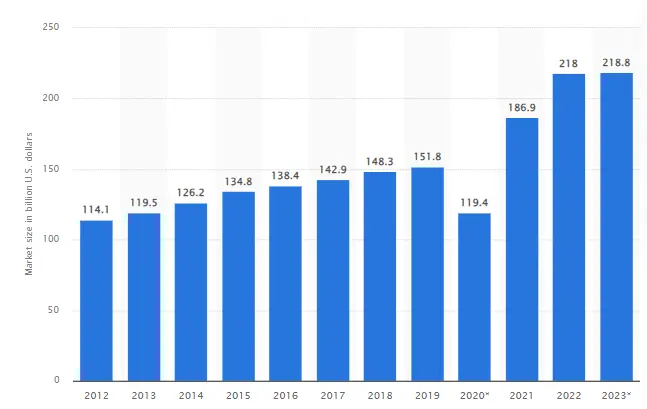
- The staffing and recruiting industry includes companies that assist organizations in finding staff.
- Based on the statistical facts, In the United States, the recruitment market size is continuously increasing. In 2021 it was 189.9 billion U.S. dollars, which has increased to 218.8 billion U.S dollars in 2023.
- The market size of the recruitment industry was worth $686.22 billion in 2022 and was estimated to reach $1778.9 billion by the year-end 2030. It is estimated to grow at a CAGR of 12.7% from the year 2022 to the year 2030.
- As per the reports of Forbes, several dollars are being spent on job advertising. On average, companies used to spend $4000 per candidate on interviewing, scheduling, and assessing to decide, if the selected candidate is right for the particular job.
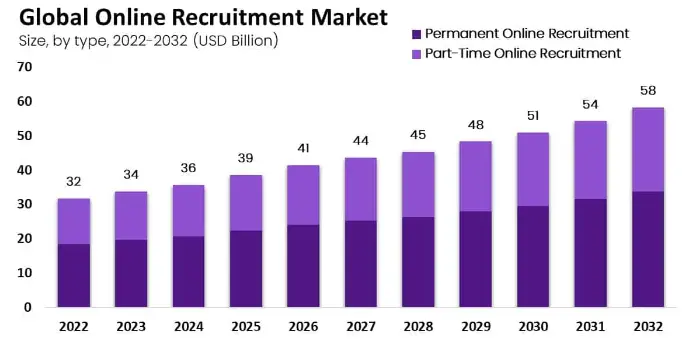 The global online recruitment market is expected to reach a value of USD 58 billion by the year-end 2032.
The global online recruitment market is expected to reach a value of USD 58 billion by the year-end 2032.- A steady growth has been expected with a rate of 6.4% annually from the year 2023 to 2032.
- During the first half of the year 2022, indeed was the most downloaded job-searching platform in the U.S., which is further followed by LinkedIn with over 40% of downloads in the year 2021.
- However, in the year 2023, LinkedIn had become one of the largest audiences with 200 million users in the U.S.
- In 2018, the Hospitality industry was the top industry with a larger number of applications per job worldwide.
- By the year 2022, the staffing and recruitment industry sales have significantly increased and have reached approx. 186 billion U.S. dollars. However, in the year 2020, the largest recruiting firm was Randstad with more than 20 million U.S. dollars in revenue.
Thus, from the above information, it can be stated that the recruitment and staffing industry has been among the fastest-growing industries in the world. Investing in this industry increases the chances of earning high revenue in the coming years.
A List of Popular Recruitment Apps
Now, you know the current statistical revenue of the recruiting and staffing industry and the reason behind investing in this industry. Every person would like to invest in an industry that can increase the profit margin of an individual. All they need is the right guidance to invest in the recruitment industry and to build an app like Indeed.
Let’s have an idea about the list of popular recruitment apps that have a wide market share and an effective number of users.
| Recruitment App | Number of Users (Estimate) | Number of Downloads (Estimate) |
| LinkedIn Recruiter | 750,000+ | 50,000,000+ |
| Indeed Employer | 500,000+ | 10,000,000+ |
| Glassdoor for Employers | 300,000+ | 5,000,000+ |
| ZipRecruiter | 250,000+ | 10,000,000+ |
| SmartRecruiters | 200,000+ | 1,000,000+ |
| Workable | 150,000+ | 1,000,000+ |
| JazzHR | 100,000+ | 500,000+ |
| Lever | 75,000+ | 500,000+ |
| Greenhouse | 50,000+ | 500,000+ |
| Bullhorn | 25,000+ | 500,000+ |
Amazed by the number of downloads of LinkedIn? Now, think about the current revenue that LinkedIn holds being the leading recruitment app in the world. In the Fiscal year 2023, the annual revenue of LinkedIn amounted to more than 15 billion U.S. dollars. The number of downloads can vary depending on the usage of the app with the changing time.
LinkedIn is followed by Indeed, then Glassdoor, and others. This represents the popularity of the apps and the scope of growth of the recruitment and staffing industry.
What Makes the Recruitment Apps so Popular?
After looking forward to the growth of recruitment apps, let’s learn the best job search apps and what makes them so popular. Identifying the features of the most popular apps can help you to evaluate their unique selling points (USP). This can further be used to make your own app USP. So shall we begin with the features?
Let’s catch the basic features first and then advance features of the apps a bit later. Here a table can help you to differentiate among the features based on usability of candidates and for admin.
Basic Features
| Feature | User Usability (Candidates) | Admin Usability (Recruiters/Hiring Managers) |
| Job Posting |
|
|
| Applicant Tracking |
|
|
| Candidate Communication |
|
|
| Resume Extraction |
|
|
| Interview Scheduling |
|
|
| Basic Analytics |
|
|
Want to know, more detail about the basic features and their usage? Here you go.
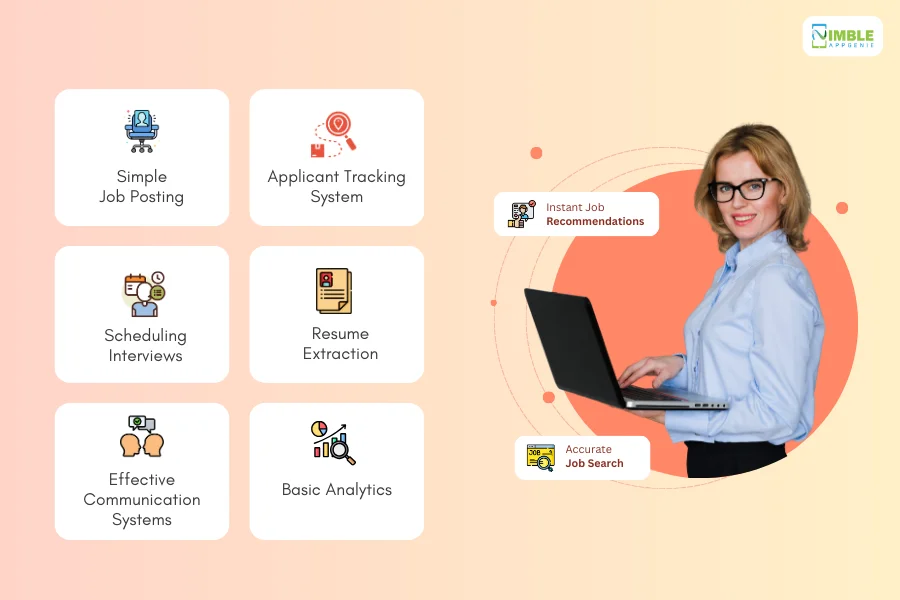
1. Simple Job Posting
The recruitment apps should be developed in a way to handle the basic searches with the capability to have a click-to-call option. The candidate must have the ability to view and search for job openings within the app.
For admin, the software should be developed in a way that they can create and manage the job openings easily. Here the jobs should be synced automatically with the applicant tracking system (ATS).
2. Applicant Tracking System
It is a type of software that is essential for businesses to track, select, and hire candidates for vacant positions in the organization. Also, the admin can use the job-specific filters to select the most qualified candidates for thorough interviews and considerations. Here, the user can track and submit their applications, also can view and update their profiles.
3. Effective Communication Systems
The app should also contain a simple communication channel and an approachable medium for the candidates to contact their dream company.
Here, the communication channel should be developed to assist the managers in connecting with the recruiters and the hiring managers. For recruiters, the application should be useful to send messages and to connect with the applicant.
4. Resume Extraction
The recruitment app should allow the candidates to upload their resumes and also to have their CVs extracted for the relevant details. On the other hand, for the admins, there should be an automatic resume selection feature based on the selection criteria.
It can assist the admin to extract the required application significantly to identify the right candidate for the right post.
5. Scheduling Interviews
A recruitment app should be capable of scheduling an interview with the assistance of the applicant tracking system. There should be an easy integration with the hiring managers that can assist the user in scheduling an interview effectively. For the admin, the app should be used to coordinate the interview schedules with the candidate profiles.
6. Basic Analytics
The application should be developed in a way to provide a basic analysis platform for the user to identify who has reviewed their application in order to reach their targeted company. For the admin, the app should be available to monitor the recruitment metrics, including applicant volume, time to fill, and others.
Apart from the basic features, there are certain advanced features that you can consider prior to develop your Recruitment app.
Advanced Features
| Features | User Usability (Candidates) | Admin Usability (Recruiters/Hiring Managers) |
| AI-Powered Candidate Matching |
|
|
| Video Interviewing |
|
|
| Assessment and Testing |
|
|
| Collaborative Hiring |
|
|
| Mobile Optimization |
|
|
| Customization and Integration |
|
|
| Candidate Experience Enhancements |
|
|
| Data Analytics and Insights |
|
|
| Compliance and Security |
|
|
Want to know more details about the advanced features and their usage? Here you go.
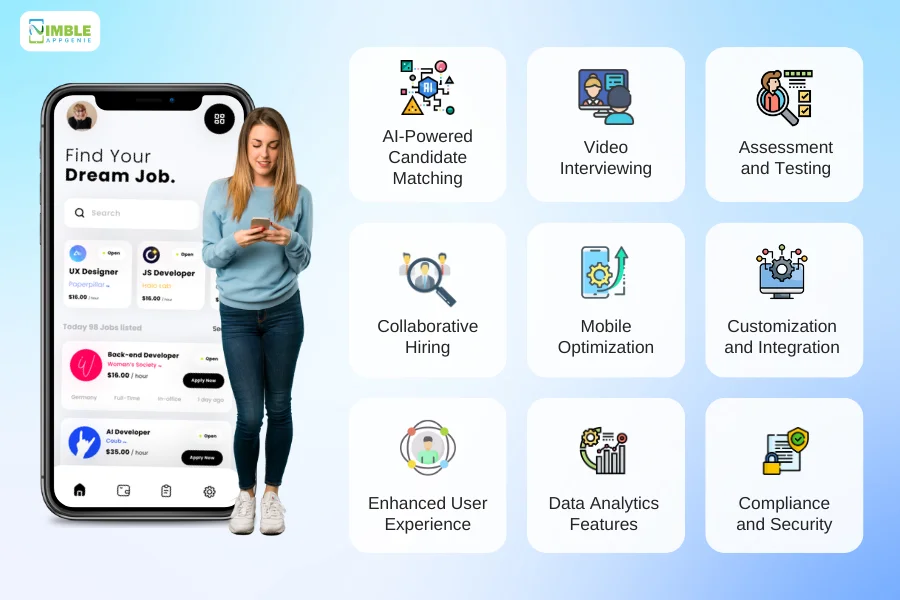
1. AI-Powered Candidate Matching
In the current era, AI has become one of the important technologies to be implemented in every application. It has become one of the crucial applications that can be implemented for recruitment practices.
With AI, the candidate can receive personalized job opportunities based on their resumes. Similarly, for recruiters, AI technology can develop automated mobile app to filter out the most preferred job application.
2. Video Interviewing
The pre-recorded interviews provide a chance for the candidate to showcase their applications. This feature assists the candidates utilize a mobile-friendly format.
Also, here the admins can conduct live or recorded videos to collaborate with the team members. Interviews can be conducted anytime and anywhere to identify their proficiency in different hard and soft skills.
3. Assessment and Testing
Within this advanced feature, the candidate can test their skills with simple steps. This feature is more helpful to hiring managers as they can screen the candidates automatically based on the candidates’ skills.
Moreover, this feature is helpful for the hiring managers to select the candidates eliminating biased practices.
4. Collaborative Hiring
Collaborative hiring is one of the efficient practices, where the recruiter can receive feedback and evaluations from various recruiters.
For the hiring manager, collaborative hiring is important for enabling the managers to get the expertise of different employees in order to reach the optimal decisions. Collaborate hiring also promotes open communication for bringing transparency.
5. Mobile Optimization
It is an important feature, where providing access to job listings, and communication features to candidates from remote locations can be availed.
Apart from this, for hiring managers, organizations can optimize the career apps to become mobile-friendly. This can assist the managers in operating the app, from remote locations.
6. Customization and Integration
The mobile recruitment application should be developed in a customized manner, based on the preferences of the candidates to manage their accounts simply.
Similarly, the platform should be agile based on the requirements of different industries’ HR managers to enable them to hire the right employees for the right posts.
7. Enhanced User Experience
In the current era, user satisfaction is the ultimate key to growing businesses. Hence, it has become one of the essential responsibilities of the mobile app development company, to develop an app that fulfills client’s requirements in order to manage user experience. Considering effective UX design principles assist admins in connecting and engaging their customers successfully.
8. Data Analytics Features
Candidates can observe personalized insights as well as recommendations with the assistance of the data analytics feature.
Here, the app also provides analytical measures to the recruiter to successfully evaluate the recruitment metrics in order to identify diversified trends for optimizing the hiring procedure.
9. Compliance and Security
Within the app, building compliance as well as security features is essential that assist the candidate in trusting the software application. Apart from this, the recruitment application should comply with the rules and regulations of the apps. It should provide security to the client’s data with robust security measures.
Are you bothered about how much does it cost to have an app with all these mentioned features?
Relax! Mobile app development cost does not take much, it’s feasible and not at all costly as much as you think.
Should You Build a Recruitment App? If Yes, Then How?
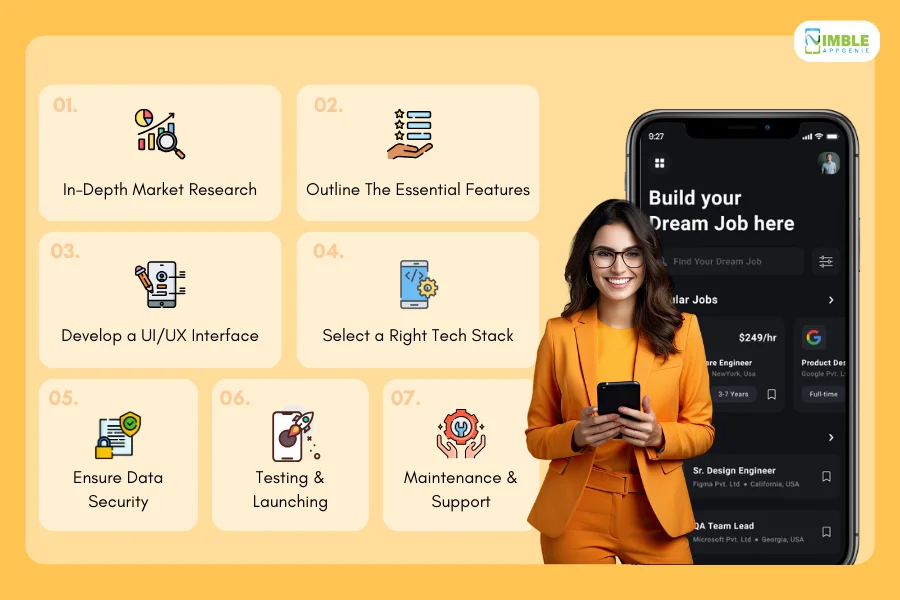
Till now, you must have understood the key features that the most popular apps offer to their customers. through which they are successfully leading the recruitment and staffing industry.
Now it’s time to learn how to develop a job portal application. Let’s have a procedure that can assist you in building a recruitment app. So, shall we head to how to build a recruitment app?
Step 1- Perform In-Depth Market Research
Knowing the market and the customers’ demands is one of the significant parameters before having your own app. You can conduct market research based on the current customers’ demands to know what candidates seek in a perfect recruitment app.
Here, you can conduct detailed market research by analyzing the market along with the availability of the current apps within the market. Know the unique selling points of the most famous apps.
Step 2- Outline the Essential Features
Note down all the essential features that you need in your recruitment app. Here you should be very particular about the key features that your app can have.
This can also include creating your app’s unique selling point for enhancing the audience’s connectivity with your brand. Identify the core features that you can insert in your app to make your app stand out from the competitors.
Step 3- Develop a UI/UX Interface
This step requires you to hire mobile app developers to engage the right audience by developing an effective recruitment app interface.
Develop a wireframe for your app with your app developers. Understand the type of interface that can assist you in engaging your customers. Here you can check with the interface of your competitors to understand the wireframe you require in your app.
Step 4- Select a Right Tech Stack
Choosing the correct tech stack can assist you in developing a right tech framework. Here you need to identify what kind of language and coding can help you in building your recruitment app.
The complete backend framework can be developed in this step. By developing the backend infrastructure for storing the data, integration with the external systems, and processing of the data, you can enhance your app structure.
Step 5- Ensure Data Security
Invest in the data and app security feature to protect your end users’ data as it can help you develop the trust of your customers.
Implement robust security measures in the app as it can assist you in improving the user experience. Data security plays an important role in ensuring the growth of businesses. The security tactics also protect your app from malicious software along hacking attempts.
Step 6- Testing and Launching
In this phase, you need to test the app and reduce all the bugs, if found. Conduct a thorough testing of the app automated testing tools. Identify if there are any usability issues and performance bottlenecks.
Testing of the app is essential because it enhances the user experience in addressing and meeting regulatory requirements. After resolving all the issues that appear after testing an app. You can launch the app and promote it through marketing.
Step 7- Maintenance and Support
This is the last and never-ending step. Here, you should update your app regularly by maintaining the app. Mobile app maintenance services are crucial to stand out in the competitive environment. Gather user feedback, and regularly keep updating your recruitment app.
Also, stay informed related to the industry guidelines for developments and to maintain a competitive edge within the recruitment app market.
How Nimble AppGenie Can Help?
Unique selling points of an app help it to survive in the industry and is essential to sustain. Moreover, to find USP, you need to perform effective market research.
Stop! You need not to perform any research when we are here for you. With the best Job portal development company, have the best experience to build your recruitment app.
Nimble AppGenie can assist you in developing an outstanding job recruitment app that will contain its own USP to sustain in the market.
Contact us to know more.
Conclusion
In conclusion, it can be said that recruitment apps are developed to aid businesses and recruiters in improving their hiring practices. These applications are also built to provide a platform for job applicants to connect with recruiters.
The market for recruitment and staffing apps is continuously increasing. The revenue is also expected to be maximized in the next decade. Popular apps include LinkedIn, followed by Indeed and Glassdoor contain an enhanced number of downloads with the scope of growth in the recruitment industry.
Key features identified for developing an app are job posting, communication, AI, and many others. Further, the process of developing a recruitment app is identified. With such information, you can develop your app successfully.
FAQ
Recruitment apps are software applications designed to streamline various aspects of the hiring process for businesses. They enable recruiters, HR professionals, hiring managers, and candidates to manage job postings, applications, and communications efficiently.
The global recruitment market reached $2.1 billion in 2022 and is projected to grow significantly, with estimates suggesting a value of $1778.9 billion by 2030. The industry is witnessing steady growth, with increased spending on job advertising and a rise in online recruitment platforms.
Leading recruitment apps include LinkedIn Recruiter, Indeed Employer, Glassdoor for Employers, and ZipRecruiter, among others. These apps boast a wide user base and offer features such as job posting, applicant tracking, and candidate communication, setting them apart in the competitive landscape.
Recruitment apps offer a range of features catering to both candidates and recruiters, including job posting, applicant tracking, candidate communication, resume extraction, interview scheduling, and basic analytics. Advanced features such as AI-powered candidate matching, video interviewing, and assessment and testing further enhance user experience and efficiency.
Developing a recruitment app involves conducting market research, outlining essential features, designing a user-friendly interface, selecting appropriate technology stacks, ensuring data security, thorough testing, launching, and ongoing maintenance and support.

Niketan Sharma is the CTO of Nimble AppGenie, a prominent website and mobile app development company in the USA that is delivering excellence with a commitment to boosting business growth & maximizing customer satisfaction. He is a highly motivated individual who helps SMEs and startups grow in this dynamic market with the latest technology and innovation.
Table of Contents





No Comments
Comments are closed.